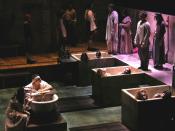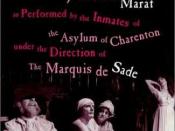A review essay by: Mikias Abebe
It is noted in many books that near the start of his career, Peter Brook was attracted to both plays and techniques that expressed human contradiction. He often wondered, though, whether there were any modern playwrights who could possibly equal the richness and complexity of Shakespearean verse, and often complained about the improbability of ever finding material to work on or to produce as stimulating as that of Shakespeare. When, in 1964, Brook received a play entitled The Persecution and Assassination of Marat as Performed by the Inmates of the Asylum of Charenton under the Direction of the Marquis de Sade (Marat/Sade), by German playwright Peter Weiss, it is also noted that Brook felt he had finally encountered the challenge of Shakespearean theater he was looking for. Not only was Marat/Sade an incredibly well written and unique approach to theater as a whole, its incorporation of music and movement, song and montage, and naturalism and surrealism within the text created the perfect passage, for Brook, from his commercial past to his experimental present, as well as a way for both the playwright and the director to deal with the concept of theater as therapy; a rather ironic, yet at the same time clever, idea seeing as how the play itself is conducted within the confines of an asylum, with the inmates themselves as the stars.
One of the most complex aspects of presenting Marat/Sade was its large and eclectic cast of characters and also its incorporation of a play within a play. On stage, these points were, looking at the opinions of a majority of both the audiences and the critics, presented successfully by Brook and the cast he worked with. From the prison guards who loomed in the background, clothed in butcher...


